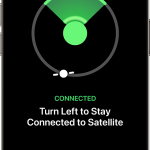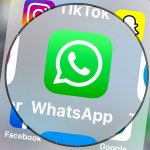Do smartphone innovations mean the death of the communication blind spot?

New technological developments will drastically reduce the likelihood of ever being unreachable by smartphone by the end of 2024.
In the first instance, this will not come as news to owners of the iPhone 14, which included satellite connectivity as one of its benefits when it launched in September 2022. But a new deal between Qualcomm and Iridium is set to bring the same kind of facility to Android smartphones in late 2023. Satellite connectivity means exactly what you think it means – in places on the Earth where traditional phone signal is not available, the phone can connect to any of the passing communication satellites orbiting the planet, and provide connection that way.
Satellite availability.
Previously an expensive, and therefore emergency-only, service, satellite smartphone connectivity is expected to become the new normal in 2024, though at present, it’s expected to remain a simple text message service, and ideally still only be used in emergencies, because of the complexity and cost implications of using satellites for messages.
Qualcomm in particular will be grateful for the Android innovation, given that its future as a contributor to iPhones looks to be evolving into extinction.
Iridium has a long history of satellite phone development, having sent its first satellite into orbit back in 1997. For a long while, it was a leading provider of ship-to-shore telephone communication for commercial shipping fleets around the world. It finished a full upgrade of its 75-satellite network in 2019, and will be looking to commercialize that development further with this move into satellite phone capabilities in the smartphone market next year.
Trickle-down technology.
It’s worth noting that this satellite messaging capability will not be initially rolled out in budget smartphones – in a marker of trickle-down technology, Qualcomm said that the satphone function, called Snapdragon Satellite, will at first only be added to the company’s premium chips, meaning it will be used as an upgrade-driver to the newest and most expensive Android handsets. An important additional factor is that the technology won’t be tied to any one smartphone manufacturer – it will be available to all makers of premium Android products, and the decision to include the chips left to the manufacturers themselves.
That’s a move aimed at both starting a “gold rush” of Android manufacturers to Qualcomm’s door – which will be handy in late 2023 as Apple continues with its plans to phase out Qualcomm chips in its iPhones – and allowing Android smartphone manufacturers to take the premium service fight to the iPhone 14, with multiple manufacturers expected to take the bait if only so they can bite Apple where it hurts.
Ultimately though, the service is expected to trickle down to both non-premium Android devices, including laptops and tablets, and also to become available as a non-emergency service.
WhatsApp-by-proxy.
In addition, while its owner Meta is racking up data misuse fines of over $400m, WhatsApp has announced it will allow its users to connect and send messages via proxy servers in the event that their regular internet connection is blocked, disrupted, or goes inexplicably “blip.”
The WhatsApp announcement comes in the wake of blackouts in Iran, which WhatsApp claims “denied human rights” and stopped people who were suddenly cut off from receiving urgently-needed help.
Again, the proxy server decision feels like one initially driven by emergency situations, but it’s also expected to go mainstream fairly quickly, with WhatsApp appealing to its two billion users worldwide to volunteer potential proxy servers for use by other users in times of need. In a blog, it also said it would offer guidance on how to set up proxy servers, to grow the network of available options.
“Connecting via proxy maintains the same high level of privacy and security that WhatsApp provides,” it claimed. “Your personal messages will still be protected by end-to-end encryption – ensuring they stay between you and the person you’re communicating with and are not visible to anyone in between, not the proxy servers, WhatsApp or Meta.”
The point of proxies.
In case you’ve never experienced sudden blackouts of internet access, proxy servers are a relatively quick way around the problem – and can be used even in cases like the Iran incident, when the blackouts were officially sanctioned by the state government. The higher the number of proxy servers available, the more difficult it becomes for any authority – whether a state government or a group of bad actors targeting individual technology clusters – to effectively clamp down on the ability of people to communicate with others and/or get news of growing situations.
WhatsApp has always provided end-to-end encryption on its messaging service (though when its fellow Meta service, Facebook Messenger, attempted to do the same, it caused uproar around the world as potentially allowing abusers and pedophiles to groom children with impunity).
The latest move from WhatsApp could be said to straddle the line between enhancing communication freedom for its user community and potentially interfering in the rights of a government to “switch off” lines of communication. While it’s unlikely that Western governments would ever invoke such rights, the proxy server move could potentially hamper attempts to monitor and/or curtail communications by extremist groups.
The combination of the coming of satellite smartphones and proxy-enabled WhatsApp messaging seem to toll the death-knell of signal blind spots within the next 12-18 months. But with the economy as it is, and the uptake for new smart devices slowing compared to previous years, they might be longer months than any of the tech giants investing in the developments expect.










